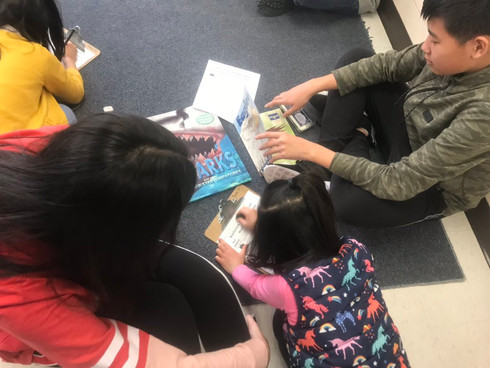Buddies- Rethinking Reading Buddies to Expand the Possibilities
- Noa Daniel

- Mar 17, 2020
- 4 min read
Reading Buddies is cool, but it can be so much more. Over the last 22 years, I have facilitated many forms of Buddies: Recess Buddies, Lunch Buddies, Literacy Buddies, Senior Citizen Buddies and, of course, Reading Buddies. Now, I try to call it Buddies because the term leaves so many more possibilities open. When I am teaching an older Grade (which is usually how it goes down), I find a partner teacher in a younger grade and begin working together to use the Buddies experience to help build relationships, deepen learning experiences while creating culture and community.

One of my most impactful Buddy partners was Rhonda Schlanger, a former Grade 1 teacher. She had been using this cool strategy by Lisa Mattes (not sure if it’s her strategy or just her graphics) for teaching decoding skills, and our buddy experiences revolved around each tool. For example, Rhonda would be teaching her students how to use the Stretchy the Snake strategy to teach how to stretch sounds. The Grade 6 Buddies would help the students craft stretchy from various materials and then help the students use stretchy and their growing tool box of strategies when reading one on one. I even adapted some of my lessons to use the language of the skill in my Grade 6 class so my students could model and teach the skill to their buddy most effectively. This helped me begin rethinking the possibilities of this learning scenario because it was about so much more than reading.
When I left my independent school and joined public school a few years ago, I had to start again as a supply teacher. The hardest part of starting over was not getting to use so many of my skills built over those 22 years. In on of my LTO's, I was elated to help the Homeroom teacher in the 3/4 class that I was also teaching develop a Buddies program. I aligned the lessons for a Grade 3-5 class with a complementary one for the K-Grade 1 class. You are welcome to use any part of this that works for you, but please credit the creator of the strategies when you do. They wanted to called it Reading Buddies.
When I got settled in my permanent job last year at Silver Pines PS, I was excited to start Buddies. The first step, besides finding a willing partner teacher and younger class, is to partner the students up strategically. Whether it’s by personality, learning needs or language skills, this is the foundation on which to build an effective Buddies program.
Another key is that it doesn't have to be a formal planning process. You can just share what you are up to in your teaching and look for common ideas with your Buddy partner teacher. For example, my students were writing narratives and developing their descriptive writing skills. The Grade 1’s were working on adjectives, so their teacher, Beth Hartleib, and I, co-read the book Rocket Write a Story over two sessions. In the first session, we had the students write the adjectives from their stories onto stickies. Both the Grade 8’s and the Grade 1’s shared their words on a a word tree. In the next session (we meet every other week), we looked at the writing process and how editing for word choice could enhance a text. The students took two new adjectives from the word tree to use in their stories. While the Grade 8’s worked with the Grade 1’s, they could transfer this lesson to their work and reference their Buddies' word choice development when evolving their own.

A few weeks ago, Beth and I had a quick planning conversation for our upcoming Buddies session while passing by in the hallway. My 8’s had been doing research for their TTalks for Impact. (I will be blogging about this year's when they are done but here's he gist: Students choose an SDG, pitch the idea for their talk, then do research on it, triangulating relevant and current data, and present on it on their selected date over a 6 week period) When Mrs. Hartleib mentioned text features, I asked if we could do something on the text features of non-fiction. She found a Non-Fiction Scavenger Hunt, and that was the extend of our planning.
When we started Buddies last week, I did a short reminder (activating schema) lesson on non-fiction text features and told the students they were going to be detectives. The Grade 1’s explored a non-fiction text of their choice with their buddies, looking for examples to complete their scavenger hunt. After seeing their frustration if their text didn't have that feature, we changed it up so that they could explore two different texts over the period. My Grade 8’s felt proud to help them while they, too, were consolidating their non-fiction text feature vocabulary.
This year, my students have done a variety of crafts as well as writing and reading tasks with our Buddies. We’ve made cards, warm fuzzies, and other constructions. We have looked at adjectives to enhance descriptiveness, and we've looked at the plot (beginning middle and end) of a story. We even have plans to go on a nature walk together. In previous years at my old school, we went on a yearly buddy trip to Bruce’s Mill- aligning our curricula and building social emotional skills through these special Buddy experiences. I'm encouraging teachers to re-think Reading Buddies as a learning opportunity for both older and younger students to deepen and consolidate skills, build relationships, and strengthen class community and culture. All learners can benefit from this 1:1 experience, and my Grade 8’s are always their best selves when they are with their Buddies.




Comments